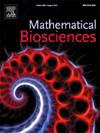Characterizing symmetry transitions in systems with dynamic morphology
IF 1.8
4区 数学
Q2 BIOLOGY
引用次数: 0
Abstract
The accurate quantification of symmetry is a key goal in biological inquiries because symmetry can affect biological performance and can reveal insights into development and evolutionary history. Recently, we proposed a versatile measure of symmetry, transformation information (), which provides an entropy-based measure of deviations from exact symmetry with respect to a parameterized family of transformations. Here we develop this measure further to quantify approximate symmetries and maximal symmetries represented by critical points in as a function of a transformation parameter. This framework allows us to characterize the evolution of symmetry by tracking qualitative changes with respect to these critical points. We apply to increasingly complex settings, from mathematically tractable probability distributions to differential equation models with emergent behaviors that are inspired by developmental biology and formulated in both static and growing domains. Our analysis of the qualitative changes in symmetry properties indicates a potential pathway toward a general mathematical framework for characterizing symmetry transitions akin to bifurcation theory for dynamical systems. The results reveal deep connections between observed symmetry transitions, subtle changes in morphology, and the underlying mechanisms that govern the dynamics of the system.
动态形态系统中对称跃迁的表征。
对称的精确量化是生物学研究的关键目标,因为对称可以影响生物性能,并可以揭示对发展和进化历史的见解。最近,我们提出了一种通用的对称度量,变换信息(TI),它提供了一种基于熵的关于参数化变换族的精确对称偏差的度量。在这里,我们进一步发展了这一措施,以量化近似对称性和最大对称性,这些近似对称性和最大对称性由TI中的临界点表示为变换参数的函数。这个框架允许我们通过跟踪这些临界点的质变来描述对称性的演化。我们将TI应用于越来越复杂的环境,从数学上易于处理的概率分布到由发育生物学启发的具有突发行为的微分方程模型,并在静态和增长领域中制定。我们对对称性质的变化的分析表明了一个潜在的途径,可以用来描述类似于动力系统分岔理论的对称转换的一般数学框架。研究结果揭示了观察到的对称转变、形态的细微变化和控制系统动力学的潜在机制之间的深层联系。
本文章由计算机程序翻译,如有差异,请以英文原文为准。
求助全文
约1分钟内获得全文
求助全文
来源期刊

Mathematical Biosciences
生物-生物学
CiteScore
7.50
自引率
2.30%
发文量
67
审稿时长
18 days
期刊介绍:
Mathematical Biosciences publishes work providing new concepts or new understanding of biological systems using mathematical models, or methodological articles likely to find application to multiple biological systems. Papers are expected to present a major research finding of broad significance for the biological sciences, or mathematical biology. Mathematical Biosciences welcomes original research articles, letters, reviews and perspectives.
 求助内容:
求助内容: 应助结果提醒方式:
应助结果提醒方式:


